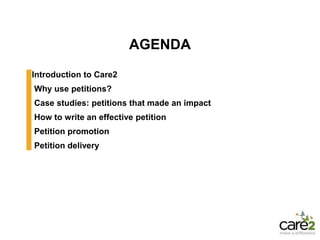The Power of The Petition
- 1. @bethgranter UK Campaigner THE WORLDâS LARGEST ONLINE COMMUNITY OF PEOPLE, BRANDS, AND CHARITIES COMING TOGETHER FOR THE GREATER GOOD.
- 2. AGENDA Introduction to Care2 Why use petitions? Case studies: petitions that made an impact How to write an effective petition Petition promotion Petition delivery
- 3. Using advocacy, community and engagement to find new supporters and donor leads
- 4. Why a petition? Petition goals Petitions can help to achieve more than a single objective: âĒ Pressure a target by showing public support for an issue âĒ Increase chances of media coverage for an issue, âĒ Raise public awareness of an issue AND a solution âĒ Increase your brand awareness âĒ Improve your brand identity âĒ Engage new and existing supporters âĒ Find out MPsâ voting intention / views on an issue âĒ Drive voting behaviour by increasing civic engagement âĒ Generate new warm contacts to convert into donors/members
- 5. Case studies: petitions that had an impact âĒ USDAW / TUC - Philip Green-BHS pensions âĒ FBU - Manchester firefighters âĒ IWGB - Deliveroo âĒ Fox hunting â against repealing the ban âĒ East Sussex mental health cuts âĒ Badger cub culling âĒ Abortion rights
- 23. How to write an effective petition An effective petition will have a strong call to action â asking people to do something and explaining why they should do it. An effective call to action has: A verb. An expected outcome. A theory of change. A sense of urgency. Reader-centered language.
- 24. How to write an effective petition 1. A verb. What is the action you want the reader to take? Without a verb, the reader has no clear sense of agency or role in your Care2 campaign. â Tell MPs to ensure equal pay for women â Pay discrimination is wrong
- 25. How to write an effective petition 2. An expected outcome. Readers need to know the end goal for the action â not just what the problem is. â Save polar bear homes from harmful drilling â Polar bear habitat at risk
- 26. How to write an effective petition 3. A theory of change - a reasonable explanation as to why a readerâs action will lead to the desired outcome. â The more people join our movement, the more pressure we can put on the Government to re-nationalise our railways. â Help us get our railways back. Sign up now.
- 27. How to write an effective petition 4. A sense of urgency. â The Council are meeting to discuss the cuts next week. Please sign my petition now to ask the Council to protect frontline services. â Please sign my petition against cutting frontline services.
- 28. How to write an effective petition 5. Reader centered language. â Could you survive on ÂĢ8 a day? If you lost your job, like hundreds of others in the UK, you could quickly find yourself homeless and hungry. Demand an end to benefit caps. â People are being left with only ÂĢ8 a day in benefits. Demand an end to benefit caps.
- 29. Petition launch and promotion Once the petition is launched the following steps will help it gain signatures: âĒ Email to existing supporters âĒ Publish on your Facebook and Twitter âĒ Directly ask influential advocates to sign and RT on Twitter âĒ Email bloggers âĒ Press release once a good number of signatures achieved, including delivery plan
- 33. Petition delivery âĒ 1. Email to target with selected comments from signers and signature PDF file âĒ 2. Email blast with each signature creating a separate email sent to target âĒ 3. Private meeting with delivery target âĒ 4. Public meeting/rally outside delivery target office Work with on-the-ground activists on a petition delivery plan:
- 41. Beth granter campaigner Email: bethg@care2team.com Twitter: @bethgranter THANK YOU









































